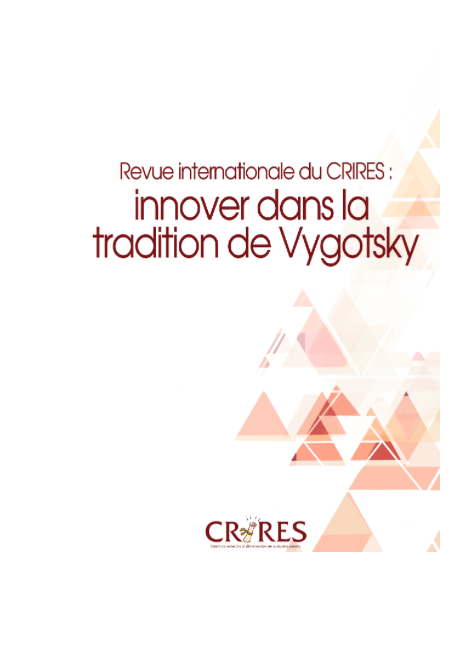Cultural historical activity theory, double stimulation, and conflicts of motives in education science: Where have we been? (2012-2021)
DOI:
https://doi.org/10.51657/ric.v5i2.51287Keywords:
Cultural Historical Activity Theory, CHAT, Double stimulation, Conflicts of motivesAbstract
Cultural Historical Activity Theory (CHAT) can be used both as a theoretical and an analytical framework. It has been used in a wide variety of contexts over a wide variety of research objects in education and other fields requiring a comprehensive understanding of interactions within a system. At a theoretical level, the relation between double stimulation and instrumental mediation has been studied and understood, yet the link between double stimulation and conflicts of motives is understudied. How has scientific literature considered this avenue for research over the past ten years? A systematic literature review was conducted, and thematic analysis was performed in order to identify themes. As of the first quarter of 2021, scientific literature in education sciences does not yet reflect the interest and potential of this research avenue. Double stimulation and its relation to conflicts of motives are key components to form volitional action in education contexts and is therefore a valuable research object.
References
Barma, S., Lacasse, M., & Massé-Morneau, J. (2015). Engaging discussion about climate change in a Quebec secondary school: A challenge for science teachers. Learning, Culture and Social Interaction, 4, 28-36.
Barnett-Page, E., & Thomas, J. (2009). Methods for the synthesis of qualitative research : A critical review. BMC Medical Research Methodology, 9(1), 59. https://doi.org/10.1186/1471-2288-9-59
Engeström, Y. (1987). Learning by Expanding. Cambridge University Press.
Engeström, Y. (2009). The future of activity theory : A rough draft. Learning and expanding with activity theory, 303‑328.
Kucirkova, N., Sheehy, K., & Messer, D. (2015). A Vygotskian perspective on parent-child talk during iPad story sharing : PARENT-CHILD TALK DURING iPAD STORY-SHARING. Journal of Research in Reading, 38(4), 428‑441. https://doi.org/10.1111/1467-9817.12030
Morselli, D., & Sannino, A. (2021). Testing the model of double stimulation in a Change Laboratory. Teaching and Teacher Education, 97, 103224. https://doi.org/10.1016/j.tate.2020.103224
Penuel, W. R. (2014). Emerging Forms of Formative Intervention Research in Education. Mind, Culture, and Activity, 21(2), 97‑117. https://doi.org/10.1080/10749039.2014.884137
Ploettner, J., & Tresseras, E. (2016). An interview with Yrjö Engeström and Annalisa Sannino on activity theory. Bellaterra Journal of Teaching & Learning Language & Literature, 9(4), 87. https://doi.org/10.5565/rev/jtl3.709
Sannino, A. (2015). The principle of double stimulation : A path to volitional action. Learning, Culture and Social Interaction, 6, 1‑15. https://doi.org/10.1016/j.lcsi.2015.01.001
Sannino, A. (2016). Double Stimulation in the Waiting Experiment with Collectives : Testing a Vygotskian Model of the Emergence of Volitional Action. Integrative Psychological and Behavioral Science, 50(1), 142‑173. https://doi.org/10.1007/s12124-015-9324-4
Sannino, A., & Laitinen, A. (2015). Double stimulation in the waiting experiment : Testing a Vygotskian model of the emergence of volitional action. Learning, Culture and Social Interaction, 4, 4‑18. https://doi.org/10.1016/j.lcsi.2014.07.002
Thompson, I. (2015). Researching contradictions : Cultural historical activity theory research (CHAT) in the English classroom. English in Australia, 50(3), 21‑26. WorldCat.org. Virkkunen, J., & Ristimäki, P. (2012). Double Stimulation in Strategic Concept Formation : An Activity-Theoretical Analysis of Business Planning in a Small Technology Firm. Mind, Culture, and Activity, 19(3), 273‑286. https://doi.org/10.1080/10749039.2012.688234
Zahedi, M., Tessier, V., & Hawey, D. (2017). Understanding Collaborative Design Through Activity Theory. The Design Journal, 20(sup1), S4611‑S4620. https://doi.org/10.1080/14606925.2017.1352958
Downloads
Published
Issue
Section
License
Copyright (c) 2022 Guillaume Isaac, Syvie Barma, Margarida Romero

This work is licensed under a Creative Commons Attribution-NonCommercial-NoDerivatives 4.0 International License.

